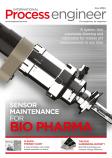Oliver Lüer reveals why a distance knocker offers advantages for many different process plant applications
It is not always possible to attach a pneumatic knocker directly to a silo, for instance, if the container becomes hot or if it moves. In such cases, the pneumatic distance knocker from singold gerätetechnik offers a solution. Company founder Erwin Lüer developed it using advanced engineering.
The basic concept is the same as that of the traditional pneumatic knocker: spontaneously released compressed air pressure accelerates the impact piston, which is designed as a permanent magnet, after it is released. In contrast to the conventional knocker, the distance knocker’s piston rod strikes a moving impulse part, which is strongly accelerated according to the impulse-momentum theorem and ultimately transfers the energy to the container to be knocked off. This process takes place at such a high speed that the human eye can hardly perceive it. Thanks to the additional impulse part, the Distance-Knocker QJ can be mounted at a distance from the silo; this means an enormous extension of the application possibilities.
A wide range of possible applications
The distance knocker is always the method of choice when a successful cleaning can be achieved with a hammer blow but a classic knocker cannot be mounted directly on the container due to the temperature or movement of the object to be knocked off. This applies, for example, to filling and emptying stations with changing containers, rotating drums and silos with hot walls.
Because of the spacing, the distance knocker can be used, for example, in rotary kiln drying systems with surface temperatures of up to 300°C and more. The QJ is also suitable for automatically knocking off filter cups or filter baskets of different sizes. A design with a thread at the end of the piston rod even makes it possible for the impact body and thus the impact geometry to be adapted case-specifically to any conceivable application situation. For example, Vulkollan buffers at the end of the piston rod are available as accessories. This makes the distance knocker a valuable tool in many different industries and types of plants: from agriculture to powder metallurgy and steel production to the textile, pharmaceutical and food industries.
The optimal version for a company’s individual requirements depends on many parameters, such as the thickness of the sheet metal, the material and diameter of the container or the drum, as well as the operating temperature. The singold gerätetechnik service team advises on the selection of the ideally suited knocker and is happy to work out completely new application possibilities with creative application engineers.
Knocking only occurs when needed
Compared with conventional ball housings, for example, the Distance-Knocker QJ produces about 20 times the impact energy. Another advantage of the distance knocker is that while ball housings cannot be switched off when the drum is rotating, the QJ knocks on demand – i.e. only when it is needed for the process. This also benefits sound insulation and thus employee health.
The distance knocker is available in different sizes. The bridged distance to the element to be knocked off varies between 25mm and 35mm. In addition, the piston rod is available in an extended version that can increase the distance of the knocker to the container by another 200mm. In the case of very hot walls in particular, it is necessary to set the distance between the knocker and the container as high as possible. The temperature of a knocker should not exceed 140°C because otherwise the seals and other parts would wear out too quickly.
As sophisticated as the invention of Erwin Lüer is, it is nevertheless simple in construction. What this means for the end user is that the Distance-Knocker QJ proves to be a low-maintenance tool in operation. Should a component ever need to be replaced, the knocker is simply disassembled and quickly reassembled.
Oliver Lüer is with singold gerätetechnik


















